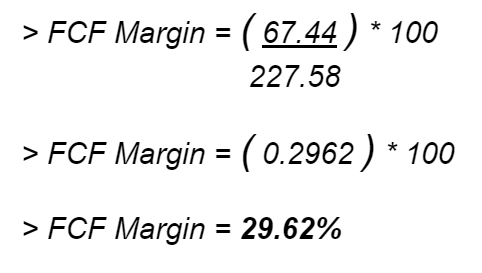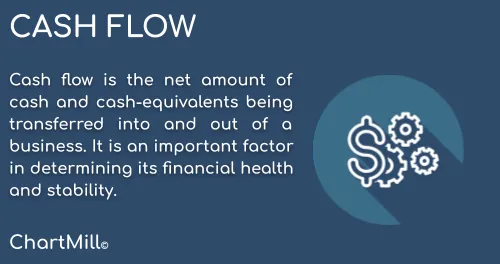Mastering Cash Flow Analysis: The Importance of FCF Margin
By Kristoff De Turck - reviewed by Aldwin Keppens
Last update: Apr 19, 2024
Free Cash Flow (FCF) margin is a financial metric that measures the percentage of revenue a company generates as free cash flow, relative to its total revenue.
It is the cash generated by a company's operations that is available for distribution to its investors (such as shareholders and debtholders) or for reinvestment in the business.
The FCF margin is calculated using the following formula:

The components of the formula are defined as follows:
Free Cash Flow (FCF):
This is calculated as the operating cash flow minus capital expenditures. More on FCF can be found in this article.
Revenue:
This is the total amount of money generated by a company's primary operations.
Once you have calculated the Free Cash Flow and the Revenue, you can use the formula to find the FCF margin, expressed as a percentage.
The FCF margin indicates the proportion of a company's revenue that is converted into free cash flow, providing insight into its ability to generate cash after covering operating and capital expenses.
A higher FCF margin is generally considered favorable, as it suggests that a larger percentage of revenue is being converted into free cash flow.
Example: Microsoft FCF Margin
(Based on data from 2023/12/31 TTM)
Free Cash Flow: $67.44B
Revenue: $227.58B

Microsoft's Free Cash Flow margin is approximately 29.62%. This means that around 29.62% of Microsoft's total revenue is converted into free cash flow after accounting for operating and capital expenses.
Why Should You Use the FCF Margin Metric?
It is a useful financial metric for several reasons:
Cash Generation Efficiency:
The FCF margin provides insight into how efficiently a company is able to convert its revenue into free cash flow.
It helps investors and analysts assess the company's ability to generate cash from its core operations.
Sustainability of Cash Flows:
By analyzing the FCF margin over time, stakeholders can evaluate the sustainability of a company's cash flows.
A consistently high or improving FCF margin may indicate a healthy and sustainable business model.
Financial Health:
A positive FCF margin suggests that a company has excess cash generated from its operations after covering both operating expenses and capital expenditures.
This surplus cash can be used for dividends, share buybacks, debt reduction, or future investments.
Investment and Capital Allocation Decisions:
Companies with a strong FCF margin have flexibility in making strategic decisions. They can reinvest in the business, pursue new opportunities, or return value to shareholders.
Investors often look for companies with a solid track record of positive FCF margins when making investment decisions.
Risk Assessment:
A declining FCF margin or a consistently low margin relative to peers may signal potential financial risks.
It could indicate challenges in managing operating expenses, increasing capital expenditures, or facing difficulties in generating cash from core business activities.
Comparative Analysis:
Comparing the FCF margin of a company with its industry peers allows for benchmarking.
It helps in understanding how well a company performs in terms of generating free cash flow relative to others in the same sector.
In summary, the FCF margin is a valuable metric for assessing a company's financial performance, efficiency, and sustainability. It offers a comprehensive view of the cash-generating capabilities and financial health of a business, making it a key factor in financial analysis and decision-making.
Related Articles
What is Cash Flow?
Cash flow is the movement of money into or out of a business. It is the net amount of cash and cash-equivalents being transferred into and out of a business. Positive cash flow indicates that a company's liquid assets are increasing, while negative cash flow means that a company's liquid assets are decreasing. Read more...
Free Cash Flow Per Share
Free cash flow per share is a financial metric that indicates the amount of cash generated by a company's operations after accounting for its capital expenditures (capex), interest expenses, and taxes. Read more...
Price to Free Cash Flow: What is it? How to calculate it? How to use it?
The Price to Free Cash Flow ratio is a valuation metric that compares a company's market price per share to its free cash flow per share. Free cash flow represents the cash generated by a company after accounting for its operating expenses, capital expenditures, and taxes. Read more...







